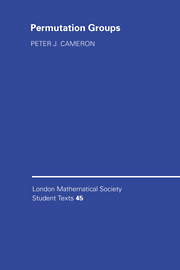1 - General theory
Published online by Cambridge University Press: 06 January 2010
Summary
History
Until about 1850, the term ‘group’ referred to a set G of transformations of a set Ω, such that G is closed under composition, contains the identity transformation, and contains the inverse of each of its elements. This is what would now be called a ‘permutation group’. (Because of the last requirement, every element of G has an inverse, and so is one-to-one and onto, that is, a permutation.)
In the modern, axiomatic approach, a group is a set with a binary operation (a function from G2 to G) which satisfies the closure, associativity, identity and inverse laws. (In fact, closure is not necessary, since a binary operation satisfies it by definition. It remains as a historical relic.)
Of course, the two approaches are essentially the same; we take the modern viewpoint because we do not want to restrict group elements to being transformations of something. Any permutation group is an abstract group with the operation of function composition (since this operation is necessarily associative). Conversely, Cayley's Theorem asserts that any abstract group is isomorphic to a transformation group. Note that, though the axioms (apart from the associative law) match up, the interpretation is different: the identity in an abstract group is defined by its properties with respect to the group operation, and has to be proved unique; the identity in a permutation group is a specific function.
There are two good practical reasons for preferring the modern approach. First, the same group may act as a permutation group on more than one set.
- Type
- Chapter
- Information
- Permutation Groups , pp. 1 - 34Publisher: Cambridge University PressPrint publication year: 1999



